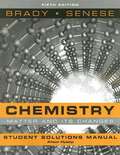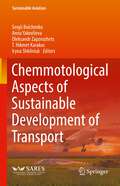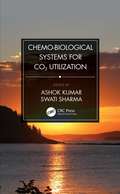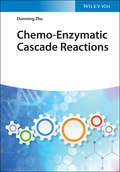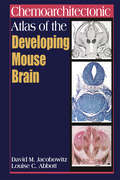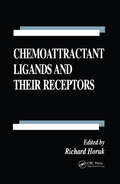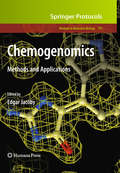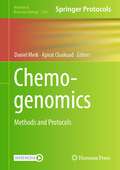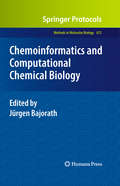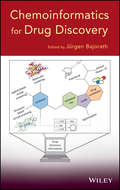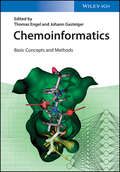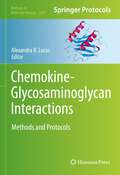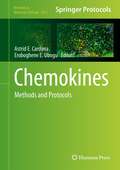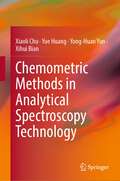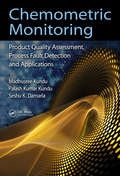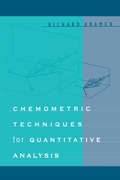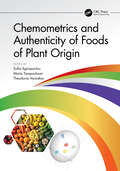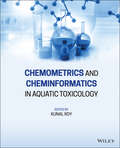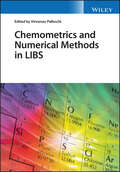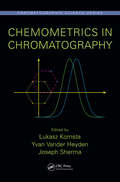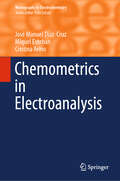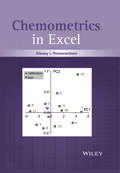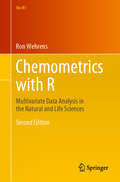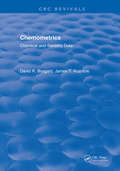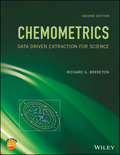- Table View
- List View
Chemistry:Matter and Its Changes (Student Solutions Manual) (Fifth Edition)
by James E. Brady Fred SeneseWritten by Jim Brady, an author well known for his ability to communicate chemistry, and Fred Senese, the architect of the most visited general chemistry Web site, this book and its media are designed to support a variety of backgrounds. It maintains its hallmark feature of accurate, lucid, and interesting explanations of the basic concepts of chemistry as well as its comprehensive coverage and aid to readers in developing problem solving skills.
Chemmotological Aspects of Sustainable Development of Transport (Sustainable Aviation)
by T. Hikmet Karakoc Sergii Boichenko Anna Yakovlieva Oleksandr Zaporozhets Iryna ShkilniukThis book looks at chemmotological solutions to important questions surrounding sustainability and environmental safety of transport — both key priorities within the global strategy of sustainable development. Bringing together expanded versions of selected papers presented at the 8th International Scientific-Technical Conference: Problems of Chemmotology – Theory and Practice of Rational Use of Conventional and Alternative Fuels and Lubricants, contributors present solutions to problematic questions, including choosing feedstock and technologies of its processing for manufacturing alternative fuels, development and implementation of measures for improving environmental safety of transport, minimizing exhaust gases emission from transport, introducing new solution or improvements in systems of fuels supply and infrastructure, and changes in legislative and regulatory base for fuels and lubricants use. This collection will be an invaluable reference for researchers, professionals, and students involved in alternative aviation fuels, transport engineering, sustainable transport development, and fuels and lubricants.
Chemo-Biological Systems for CO2 Utilization
by Ashok Kumar Swati SharmaChemo-Biological Systems for CO2 Utilization describes the most recent advanced tools and techniques for carbon dioxide capture and its utilization. It discusses and compares the advantages of different systems and aids researchers and industrialists in understanding energy generation in the form of biofuels, bioelectricity, or biogas using chemicals; nanomaterials; and microbial, enzymatic, and chemo-enzymatic-integrated systems. It describes the importance and utilization of CO2 in living systems, and provides an overview of the various fundamental methods, policies, and techniques involved in CO2 conversion. Emphasis is placed on the production of value-added products using CO2, including biomethanol, industrial carbonates, and liquid or gaseous fuels. Features: Explains the correlations between microbial, biological, and chemical products and their roles in the conversion of CO2 into usable energy and related products. Being suitable for a broad audience, it addresses fundamental treatment methods for reusing environmental waste materials. Aids in decision-making and policy planning for environmental professionals. The information provided throughout this book will help researchers and professionals working in various industries to better understand the conversion of CO2 into energy-based products. Chemo-Biological Systems for CO2 Utilization also serves as a useful guide to seek alternative methods for clean energy and mitigating global climate change.
Chemo-Enzymatic Cascade Reactions
by Dunming ZhuA unique book that explores biocatalytic-chemical cascade reactions and their applications in the synthesis of valuable chemicals.
Chemoarchitectonic Atlas of the Developing Mouse Brain
by David M. Jacobowitz Louise C. AbbottRepresenting the state-of-the-art in neurochemical mapping, Chemoarchitectonic Atlas of the Developing Mouse Brain provides a complete, full-color look at the developing mouse brain. Hundreds of coronal sections are presented, clearly illustrating structures at progressive stages of brain development.
Chemoattractant Ligands and Their Receptors (Handbooks In Pharmacology And Toxicology Ser. #38)
by Richard HorukChemoattractant Ligands and Their Receptors succinctly summarizes cutting-edge research in the important area of chemoattraction in immunology. It explains how chemoattractant molecules mobilize immune cells to ward off attack by invading pathogens, both at a molecular and at a cellular level. Written by acknowledged experts in the field, it contains detailed molecular and structural information on each of the major chemoattractants and their receptors. Its unique multidisciplinary approach encompasses biology, immunology, protein chemistry, and molecular biology. A time-saving reference for both researchers and students.
Chemogenomics: Methods and Applications (Methods in Molecular Biology #575)
by Edgar JacobyThe establishment, analysis, prediction, and expansion of a comprehensive ligand-target Structure-Activity Relationship (SAR) in the post-genomic era presents a key research challenge for this century. In Chemogenomics: Methods and Applications, experts from academia and industry explore cutting-edge in vitro and in silico approaches available today and outline the relevant aspects of chemistry, biology, and molecular informatics which are the cornerstones of chemogenomics, thus combining introductory concepts with detailed methods and protocols. Covering topics such as target family-oriented compound library design, drug discovery targeting the purinome and co-factor binding sites, as well as the pocketome engine and molecular interaction field approaches, the book emphasizes systemization as an advantage to furthering the difficult science of drug discovery. As a volume in the highly successful Methods in Molecular BiologyTM series format, this work provides the kind of detailed description and implementation advice that is crucial for getting optimal results. Authoritative and practical, Chemogenomics: Methods and Applications presents content which will be of enormous value to those striving for the discovery of new and better therapies for diseases.
Chemogenomics: Methods and Protocols (Methods in Molecular Biology #2706)
by Daniel Merk Apirat ChaikuadThis volume presents both theoretical guidance and protocols on chemogenomics including chemogenomics library assembly, compound profiling, and phenotypic assays. The chapters in this book cover topics such as the assembly and use of Kinase Chemogenomics; data mining for chemogenomic compound candidates; protocols for protein family-focused assay systems to profile chemogenomic compounds; functional and target engagement assays in cellular settings for broad characterization; and a discussion on phenotypic assays where chemogenomic sets may be applied. Written in the highly successful Methods in Molecular Biology series format, chapters include introductions to their respective topics, lists of the necessary materials and reagents, step-by-step, readily reproducible laboratory protocols, and tips on troubleshooting and avoiding known pitfalls.Cutting-edge and thorough, Chemogenomics: Methods and Protocols is a valuable resource for all researchers who are interested in learning more about this diverse and developing field.
Chemoinformatics and Computational Chemical Biology (Methods in Molecular Biology #672)
by Jürgen BajorathOver the past years, the chem(o)informatics field has further evolved and new application areas have opened up, for example, in the broadly defined area of chemical biology. In Chemoinformatics and Computational Chemical Biology, leading investigators bring together a detailed series of reviews and methods including, among others, system-directed approaches using small molecules, the design of target-focused compound libraries, the study of molecular selectivity, and the systematic analysis of target-ligand interactions. Furthermore, the book delves into similarity methods, machine learning, probabilistic approaches, fragment-based methods, as well as topics that go beyond the current chemoinformatics spectrum, such as knowledge-based modeling of G protein-coupled receptor structures and computational design of siRNA libraries. As a volume in the highly successful Methods in Molecular BiologyTM series, this collection provides detailed descriptions and implementation advice that are exceedingly relevant for basic researchers and practitioners in this highly interdisciplinary research and development area. Cutting-edge and unambiguous, Chemoinformatics and Computational Chemical Biology serves as an ideal guide for experts and newcomers alike to this vital and dynamic field of study.
Chemoinformatics for Drug Discovery
by Jürgen BajorathChemoinformatics strategies to improve drug discovery results With contributions from leading researchers in academia and the pharmaceutical industry as well as experts from the software industry, this book explains how chemoinformatics enhances drug discovery and pharmaceutical research efforts, describing what works and what doesn't. Strong emphasis is put on tested and proven practical applications, with plenty of case studies detailing the development and implementation of chemoinformatics methods to support successful drug discovery efforts. Many of these case studies depict groundbreaking collaborations between academia and the pharmaceutical industry. Chemoinformatics for Drug Discovery is logically organized, offering readers a solid base in methods and models and advancing to drug discovery applications and the design of chemoinformatics infrastructures. The book features 15 chapters, including: What are our models really telling us? A practical tutorial on avoiding common mistakes when building predictive models Exploration of structure-activity relationships and transfer of key elements in lead optimization Collaborations between academia and pharma Applications of chemoinformatics in pharmaceutical research—experiences at large international pharmaceutical companies Lessons learned from 30 years of developing successful integrated chemoinformatic systems Throughout the book, the authors present chemoinformatics strategies and methods that have been proven to work in pharmaceutical research, offering insights culled from their own investigations. Each chapter is extensively referenced with citations to original research reports and reviews. Integrating chemistry, computer science, and drug discovery, Chemoinformatics for Drug Discovery encapsulates the field as it stands today and opens the door to further advances.
Chemoinformatics: Basic Concepts and Methods
by Thomas Engel Johann GasteigerThis essential guide to the knowledge and tools in the field includes everything from the basic concepts to modern methods, while also forming a bridge to bioinformatics.The textbook offers a very clear and didactical structure, starting from the basics and the theory, before going on to provide an overview of the methods. Learning is now even easier thanks to exercises at the end of each section or chapter. Software tools are explained in detail, so that the students not only learn the necessary theoretical background, but also how to use the different software packages available. The wide range of applications is presented in the corresponding book Applied Chemoinformatics - Achievements and Future Opportunities (ISBN 9783527342013). For Master and PhD students in chemistry, biochemistry and computer science, as well as providing an excellent introduction for other newcomers to the field.
Chemokine-Glycosaminoglycan Interactions: Methods and Protocols (Methods in Molecular Biology #2597)
by Alexandra R. LucasThis detailed volume provides methods to guide assay development, procedures designed to investigate the chemokine and glycosaminoglycan (GAG) networks, as well as their interactions, in a wide range of organs and tissues in disease and in health. The initial chapters in this book present in vivo models used to examine the roles of chemokines and GAGs in normal physiology and in the pathophysiology of disease. The book then explores present cell- and tissue-based in vitro assays to examine chemokine:GAG interactions. Finally, analytic approaches are presented that provide assays for measuring GAGs, chemokines, and cellular responses. Written for the highly successful Methods in Molecular Biology series, chapters include introductions to their respective topics, lists of the necessary materials and reagents, step-by-step and readily reproducible laboratory protocols, and tips on troubleshooting and avoiding known pitfalls. Authoritative and practical, Chemokine-Glycosaminoglycan Interactions: Methods and Protocols serves as an ideal guide for researchers seeking to analyze chemokine and GAG functions, interactions, and molecular mechanisms in vivo and in vitro.
Chemokines: Methods and Protocols (Methods in Molecular Biology #1013)
by Eroboghene E. Ubogu Astrid E. CardonaChemokines constitute a large family of structurally similar cytokines that contain a signature of conserved cysteine residues joined by disulfide bridges. Binding of chemokines to specific G protein-coupled receptors followed by downstream signaling defines their biological function. Initially, chemoattraction was the key function linked to chemokines/chemokine receptors; however, in recent years, it has become clear that chemokine ligand-receptor interactions can also modulate cellular activation, survival, and proliferation, among other functions in homeostatic and diseased states. Importantly, major advances in our understanding of chemokine biology have led to chemokine receptors becoming specific therapeutic targets with great potential. In Chemokines: Methods and Protocols, expert researchers provide practical information regarding experimental models and state of the art protocols used to delineate chemokine/chemokine receptor function and their applications in health and disease. Written in the highly successful Methods in Molecular Biology series format, chapters include introductions to their respective topics, lists of the necessary materials and reagents, step-by-step, readily reproducible laboratory protocols, and tips on troubleshooting and avoiding known pitfalls. Practical and easy to use, Chemokines: Methods and Protocols aims to reveal key protocols of functional and descriptive chemokine ligand/receptor assays that will be of practical significance to graduate students, post-doctoral fellows, trainees, and researchers in academia and industry.
Chemometric Methods in Analytical Spectroscopy Technology
by Xiaoli Chu Yue Huang Yong-Huan Yun Xihui BianThis book discusses chemometric methods for spectroscopy analysis including NIR, MIR, Raman, NMR, and LIBS, from the perspective of practical applied spectroscopy. It covers all aspects of chemometrics associated with analytical spectroscopy, including representative sample selection algorithm, outlier detection algorithm, model updating and maintenance algorithm and strategy and calibration performance evaluation methods.To provide a systematic and comprehensive overview the latest progress of chemometric methods including recent scientific research and practical applications are presented. In addition the book also highlights the improvement of classical algorithms and the extension of common strategies. It is therefore useful as a reference book for researchers engaged in analytical spectroscopy technology, chemometrics, analytical instruments and other related fields.
Chemometric Monitoring: Product Quality Assessment, Process Fault Detection, and Applications
by Madhusree Kundu Palash Kumar Kundu Seshu K. DamarlaData collection, compression, storage, and interpretation have become mature technologies over the years. Extraction of meaningful information from the process historical database seems to be a natural and logical choice. In view of this, the proposed book aims to apply the data driven knowledge base in ensuring safe process operation through timely detection of process abnormal and normal operating conditions, assuring product quality and analyzing biomedical signal leading to diagnostic tools. The book poses an open invitation for an interface which is required henceforth, in practical implementation of the propositions and possibilities referred in the book. It poses a challenge to the researchers in academia towards the development of more sophisticated algorithms. The proposed book also incites applications in diversified areas. Key Features: Presents discussion of several modern and popular chemometric techniques Introduces specific illustrative industrial applications using the chemometric techniques Demonstrates several applications to beverage quality monitoring Provides all the algorithms developed for the automated device design, data files, sources for biomedical signals and their pre-processing steps, and all the process models requited to simulate process normal/faulty data Includes casestudy-based approach to the topics with MATLAB and SIMULINK source codes
Chemometric Techniques for Quantitative Analysis
by Richard KramerChemometric Techniques for Quantitative Analysis shows how to produce and use quantitative analytical calibrations in a laboratory or production environment following a variety of methods, how to estimate the time and resources needed to develop analytical calibrations, and how to employ the quantitative software provided with a wide range of instr
Chemometrics and Authenticity of Foods of Plant Origin
by Theodoros Varzakas Sofia Agriopoulou Maria TarapoulouziOne of the challenges facing the world is feeding the ever-increasing population, with food security being a growing 21st century problem. This stresses the need for coordinated international systems to prevent and mitigate food fraud in global food supply chains. Food fraud, which is usually financially motivated, has significant consequences including unfair competition, major damage to markets and organizations, loss of consumer confidence, and it raises food safety issues. A shift toward a more plant-based diet can be endorsed to promote sustainability but also to improve public health and minimize animal suffering. The aim of this book is to deal with issues related to authenticity and chemometrics of the most important food products of plant origin, such as cereals, nuts, legumes, table olives and olive oil, coffee, tea, fruits and vegetables, fruit juices, spices, mushrooms, beers and wines, and honey, using state-of-the-art analytical techniques and instrumentation coupled with available chemometric tools.
Chemometrics and Cheminformatics in Aquatic Toxicology
by Kunal RoyExplore chemometric and cheminformatic techniques and tools in aquatic toxicology Chemometrics and Cheminformatics in Aquatic Toxicology delivers an exploration of the existing and emerging problems of contamination of the aquatic environment through various metal and organic pollutants, including industrial chemicals, pharmaceuticals, cosmetics, biocides, nanomaterials, pesticides, surfactants, dyes, and more. The book discusses different chemometric and cheminformatic tools for non-experts and their application to the analysis and modeling of toxicity data of chemicals to various aquatic organisms. You’ll learn about a variety of aquatic toxicity databases and chemometric software tools and webservers as well as practical examples of model development, including illustrations. You’ll also find case studies and literature reports to round out your understanding of the subject. Finally, you’ll learn about tools and protocols including machine learning, data mining, and QSAR and ligand-based chemical design methods. Readers will also benefit from the inclusion of: A thorough introduction to chemometric and cheminformatic tools and techniques, including machine learning and data mining An exploration of aquatic toxicity databases, chemometric software tools, and webservers Practical examples and case studies to highlight and illustrate the concepts contained within the book A concise treatment of chemometric and cheminformatic tools and their application to the analysis and modeling of toxicity data Perfect for researchers and students in chemistry and the environmental and pharmaceutical sciences, Chemometrics and Cheminformatics in Aquatic Toxicology will also earn a place in the libraries of professionals in the chemical industry and regulators whose work involves chemometrics.
Chemometrics and Numerical Methods in LIBS
by Vincenzo PalleschiChemometrics and Numerical Methods in LIBS A practical guide to the application of chemometric methods to solve qualitative and quantitative problems in LIBS analyses Chemometrics and Numerical Methods in LIBS, delivers an authoritative and practical exploration of the use of advanced chemometric methods to laser-induced breakdown spectroscopy (LIBS) cases. The book discusses the fundamentals of chemometrics before moving on to solutions that can be applied to data analysis methods. It is a concise guide designed to help readers at all levels of knowledge solve commonly encountered problems in the field. The book includes three sections: LIBS information simplification, LIBS classification, and quantitative analysis by LIBS. Each section of the book is divided into a description of relevant techniques and practical examples of its applications. Contributors to this edited volume are the most recognized international experts on the chemometric techniques relevant to LIBS analysis. Chemometrics and Numerical Methods in LIBS also includes: A thorough introduction to the simplification of LIBS information, including principal component analysis, independent component analysis, and parallel factor analysis Comprehensive explorations of classification by LIBS, including spectral angle mapping, linear discriminant analysis, graph clustering, self-organizing maps, and artifical neural networks Practical discussions of linear methods for quantitative analysis by LIBS, including calibration curves, partial least squares regression, and limit of detection In-depth examinations of multivariate analysis and non-linear methods, including calibration-free LIBS, the non-linear Kalman filter, artificial and convolutional neural networks for quantification Relevant for researchers and PhD students seeking practical information on the application of advanced statistical methods to the analysis of LIBS spectra, Chemometrics and Numerical Methods in LIBS will also earn a place in the libraries of students taking courses involving LIBS spectro-analytical techniques
Chemometrics in Chromatography (Chromatographic Science Series)
by Joseph Sherma Łukasz Komsta Yvan HeydenChemometrics uses advanced mathematical and statistical algorithms to provide maximum chemical information by analyzing chemical data, and obtain knowledge of chemical systems. Chemometrics significantly extends the possibilities of chromatography and with the technological advances of the personal computer and continuous development of open-source software, many laboratories are interested in incorporating chemometrics into their chromatographic methods. This book is an up-to-date reference that presents the most important information about each area of chemometrics used in chromatography, demonstrating its effective use when applied to a chromatographic separation.
Chemometrics in Electroanalysis: Fundamentals And Applications (Monographs in Electrochemistry)
by Miquel Esteban Cristina Ariño José Manuel Díaz-CruzThis monograph covers the most relevant applications of chemometrics in electrochemistry with special emphasis on electroanalytical chemistry. It reviews the use of chemometric methods for exploratory data analysis, experimental design and optimization, calibration, model identification, and experts systems. The book also provides a brief introduction to the fundamentals of the main chemometric methods and offers examples of data treatment for calibration and model identification. Due to the comprehensive coverage, this book offers an invaluable resource for graduate and postgraduate students, as well as for researchers in academic and industrial laboratories working in the area of electroanalysis and electrochemical sensors.
Chemometrics in Excel
by Alexey L. PomerantsevProviding an easy explanation of the fundamentals, methods, and applications of chemometrics* Acts as a practical guide to multivariate data analysis techniques* Explains the methods used in Chemometrics and teaches the reader to perform all relevant calculations* Presents the basic chemometric methods as worksheet functions in Excel* Includes Chemometrics Add In for download which uses Microsoft Excel® for chemometrics training* Online downloads includes workbooks with examples
Chemometrics with R: Multivariate Data Analysis in the Natural and Life Sciences (Use R!)
by Ron WehrensThis book offers readers an accessible introduction to the world of multivariate statistics in the life sciences, providing a comprehensive description of the general data analysis paradigm, from exploratory analysis (principal component analysis, self-organizing maps and clustering) to modeling (classification, regression) and validation (including variable selection). It also includes a special section discussing several more specific topics in the area of chemometrics, such as outlier detection, and biomarker identification. The corresponding R code is provided for all the examples in the book; and scripts, functions and data are available in a separate R package. This second revised edition features not only updates on many of the topics covered, but also several sections of new material (e.g., on handling missing values in PCA, multivariate process monitoring and batch correction).
Chemometrics: Chemical and Sensory Data
by David R. BurgardRanging from elegantly simple to extremely complex, a wide variety of flavors and fragrances stimulate our senses. It is difficult to understand the myriad sensory interactions involved because of the sheer complexity of their chemical composition. The aim of this text is to describe the use of chemometric techniques for understanding these complex systems and to serve as a practical guide to the acquisition, organization and reduction of chemical and sensory data. It explains chemical, sensory and multivariate analysis tools and their application. Pertinent concepts are discussed in-depth and are sufficiently illustrated with enough original data in complementary tables and figures to provide the basis for the execution of complex studies. The book emphasizes techniques that have been proven to work rather than those that "should" work from a theoretical standpoint. The book focuses on the acquisition of quality data and the subsequent interpretation of data rather than numerical computations used in data analysis. Chemometrics: Chemical and Sensory Data is an excellent resource for students and newcomers to flavor and fragrance research, as well as for experienced workers and product development managers.
Chemometrics: Data Driven Extraction for Science
by Richard G. BreretonA new, full-color, completely updated edition of the key practical guide to chemometrics This new edition of this practical guide on chemometrics, emphasizes the principles and applications behind the main ideas in the field using numerical and graphical examples, which can then be applied to a wide variety of problems in chemistry, biology, chemical engineering, and allied disciplines. Presented in full color, it features expansion of the principal component analysis, classification, multivariate evolutionary signal and statistical distributions sections, and new case studies in metabolomics, as well as extensive updates throughout. Aimed at the large number of users of chemometrics, it includes extensive worked problems and chapters explaining how to analyze datasets, in addition to updated descriptions of how to apply Excel and Matlab for chemometrics. Chemometrics: Data Driven Extraction for Science, Second Edition offers chapters covering: experimental design, signal processing, pattern recognition, calibration, and evolutionary data. The pattern recognition chapter from the first edition is divided into two separate ones: Principal Component Analysis/Cluster Analysis, and Classification. It also includes new descriptions of Alternating Least Squares (ALS) and Iterative Target Transformation Factor Analysis (ITTFA). Updated descriptions of wavelets and Bayesian methods are included. Includes updated chapters of the classic chemometric methods (e.g. experimental design, signal processing, etc.) Introduces metabolomics-type examples alongside those from analytical chemistry Features problems at the end of each chapter to illustrate the broad applicability of the methods in different fields Supplemented with data sets and solutions to the problems on a dedicated website Chemometrics: Data Driven Extraction for Science, Second Edition is recommended for post-graduate students of chemometrics as well as applied scientists (e.g. chemists, biochemists, engineers, statisticians) working in all areas of data analysis.
